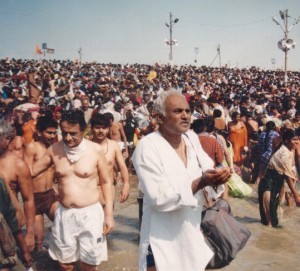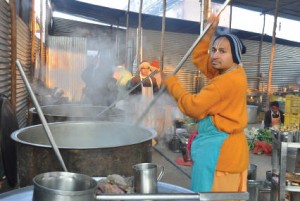A pilgrimage to the world’s greatest festival is becoming a tradition for one family from South Africa.
Twelve years ago (2001), I was presented with a once in- a-lifetime opportunity to attend the Maha Kumbha Mela in Allahabad, India. I recall boarding a flight from Durban, South Africa, to New Delhi, not knowing what to expect. I grew up hearing many stories of the festivities from my dad, Sri Nathji Dasa, who had been to the Mela in 1989 with His Holiness Indradyumna Swami. Fortunately, I was accompanying my dad, who was experienced in the expedition. Being a third-year university student at the time, I had an enquiring mind and feelings of expectation along with some trepidation as well. Nonetheless, I embraced the opportunity to delve into the sights, sounds, and holy waters.
Maha Kumbha Mela “the great festival of the urn” occurs every twelve years, the exact date determined by astrological calculations. The history of the festival dates back to the beginning of creation. The Puranas state that during a scuffle between the devas (demigods) and the asuras (demons) over a pot of immortal nectar, four drops of the nectar spilled in different parts of northern India. Since that time pilgrims have gathered to bathe in the holy waters at these places, including the confluence of the rivers Ganges, Yamuna, and subterranean Saraswati at Allahabad.
In preparation for the festival the banks of the rivers spring up with tents, creating a temporary 6,000-acre town known as Kumbh-nagar. Without knowing that police restrict vehicle access to campsites in the town, I had packed a trolley bag with essentials for my three-night stay in 2001. As we got off the overnight train from New Delhi, we were grateful to find a bicycle rickshaw, and the driver earnestly peddled his way through to the Kumbh-nagar boom-gate, the farthest point reached by any mode of transport. I tugged on my trolley bag, wheeling it with great difficulty as people pushed their way around me on the sand banks of the holy rivers. We walked alongside sadhus (holy men), naga babas (naked men smeared with ash), politicians and their supporters, yogis from the Himalaya mountains, and millions of ordinary pilgrims. None seemed intimidated by strange looks from foreigners; nor did they shy away from happy snappers. Everyone continued their journey with a purpose, searching for a place for meditation or rest.
I took in the sights and sounds all around me loud-speakers blaring lectures or music at every camp, government hailers shouting announcements, tribes of holy men and women chanting as they walked through the pathways, children clinging to their parents, yogis holding tridents or standing on their head.
As we did not speak Hindi, our search for the ISKCON camp on Sankaracharya Marg proved difficult. After walking for approximately an hour (which felt like eternity at the time), we were met by the sight of a deity of Srila Prabhupada and the deities of Gaura-Nitai small forms of Lord Caitanya and Lord Nityananda, beautifully residing on the wood-carved ox-cart of the ISKCON Padayatra, a group of devotees who tour India on foot, spreading Krishna consciousness.
My Parents’ 2013 Visit

My dad was fortunate enough to attend the Mela again this year, making this his third pilgrimage to Allahabad. Together with my mother, Pancali Devi Dasi, they ventured off to this exciting yet austere pilgrimage. They were residents at the ISKCON camp, which was abuzz with color, flavor, song, dance, and discussions. My mother described her stay at the camp with enthusiasm.
“I could not believe how the devotees managed to distribute such a variety of prasada. Cooking at the camp with gas burners and coal fires, devotees managed to prepare sumptuous meals for all. The very same prasada was distributed to both devotees staying at the camp and pilgrims walking by. There was no restriction to quantity, and nobody was turned away. It was amazing that the devotees had a gaspowered roti-maker that rolled out hot rotis for distribution. As we sat in rows at makeshift tables of bricks two tiers high, we enjoyed our meal served to us on stitched banana-leaf plates. A dedicated team of devotees, clad in warm attire, prepared the most aromatic and tasty meals.”
For Sri Nathji, attending his third Maha Kumbha Mela was a lifetime achievement.
“When Indradyumna Swami asked me to join the group from Durban going to the Mela in 1989, I did not know what to expect. But I took the plunge and never looked back it was a life-changing experience. Daily I reflect on being with my spiritual master as we walked across the riverbank, singing and dancing in kirtana. This inspired me to return in 2001. Once again, I experienced waking up in a sleeping bag on cold mornings under an army-like tent, being huddled with millions of people, and getting blisters on my feet from walking on cobblestones. Through the austerity, I once again desired to return for the third time, to be a part of the Hare Krishna experience at the Mela. Over a thirty-six-year period, I’ve watched how the ISKCON campsite has grown to become the most attractive and eventful of all.”
Camp ISKCON
Being a professional photographer, Sri Nathji was enthusiastic to capture the moments, faces, and moods of the millions at the Mela. Standing on a pontoon bridge to view the massive crowds, he noticed how the ISKCON camp stood out from the rest of the tent city.
Adorned with color and vibrancy, the entrance of the ISKCON camp was eye-catching. An illuminated bamboo structure more than thirty meters high lit the night sky. Unlike the other holy men and women, the Hare Krishna devotees were clad in Vaishnava attire of saris or dhotis. They distributed books, chanted, talked to other pilgrims about Krishna, cooked and served prasada. [See the sidebar “Following Prabhupada’s Program at the Mela.”]
The cultural program onstage was filled with enlightening talks from sannyasis and other senior devotees. Song, dance, and drama attracted thousands to the camp every day. His Holiness Lokanath Swami led the devotees in chanting and dancing through the pathways that sprawled over the riverbanks. The ocean of mercy was freely flowing as the deities of Gaura-Nitai glided through the festival.
Dina Bandhu Dasa, a senior devotee of the Krishna-Balarama Temple in Vrindavan, spoke eloquently on the pastimes of Lord Krishna. On the main stage devotees delivered discourses on the Vedas and answered thought-provoking questions from listeners.
The chilly morning weather did not deter the devotees at the camp from performing mangala-arati (early-morning worship) and the rest of the day’s spiritual observances. Although the altar was a medium-sized carved wooden structure that rested on an ox-cart, the standard of worship was meticulous and detailed. Throughout the day devotees chanted and interacted with others. The thirty-plus life size motor-controlled dioramas depicting the pastimes of the Lord were a unique feature at the camp.
A Crowded Dip In the Holy Waters
As dawn broke on Mauni Amavasya (the most auspicious bathing day of the 55-day festival), the earliest pilgrims were making their way to the bathing ghats next to Allahabad’s medieval fort. Boatmen rowed the devotees upstream to avoid the mudflats. Sri Nathji and Pancali headed to the confluence of the three rivers to take the auspicious bath. Within the festivities and packed crowds, a group of ISKCON devotees chanted and played musical instruments as they forged through to the confluence of the three rivers.
An estimated thirty million pilgrims would bathe that day. The Guinness Book of World Records has billed the Mela as the largest human gathering for a common purpose.
Prabhupada’s Merciful Perspective
When Srila Prabhupada took part in the Maha Kumbha Mela in 1977, he commented that although many attend the Mela for spiritual liberation, devotees engaged in Krishna’s service are already liberated. It is the duty of the devotees attending the Mela to use this platform to spread the names of Lord Krishna.

Following Srila Prabhupada’s instructions devotees raised the standard of creativity, organization, and devotion by providing a true Hare Krishna experience to all who visited the camp. One of the most remarkable moments was the arrival of the deity of Lord Balaji, the form of Lord Krishna from the famous Tirumala temple in South India. Senior devotees welcomed the entourage to the ISKCON camp, where South Indian priests performed the traditional marriage ceremony of Lord Balaji. The ISKCON stage was turned into a South Indian reservoir of chanting the different names of Lord Krishna. Attracted onlookers clapped and chanted to the tunes of the Hare Krishna maha-mantra.
Every piligrim passing through through the ISKCON camp received spiritual benefit by either chanting, receiving a spiritual book, partaking in a wholesome prasada meal, or seeing the beautiful deities of Gaura-Nitai. Srila Prabhupada must have been truly pleased by the efforts of the devotees.
We can all aspire to be a part of the diverse gathering known as the Maha Kumbha Mela and the Hare Krishna experience there in 2025.
Krsangi Radhe Devi Dasi, a disciple of Indradyumna Swami, lives in Durban, South Africa, with her husband, Muralidhara Dasa, and their daughters Vraja-Sundari (five years old) and Varsana-Rani (one year old). She is an English language lecturer at the tertiary level. Among other services, her main focus is to develop children in Krishna consciousness. She founded and currently hosts the “Krishna’s Kids” program at the Durban temple.
Sri Nathji Dasa, a disciple of Indradyumna Swami, lives in Durban with his wife, Pancali Devi Dasi. He joined ISKCON in 1978. Being a professional photographer, Sri Nathji uses his expertise to capture ISKCON Durban’s major events and programs, which included “Feeding the Children of the Rainbow Nation” with former President Nelson Mandela.
